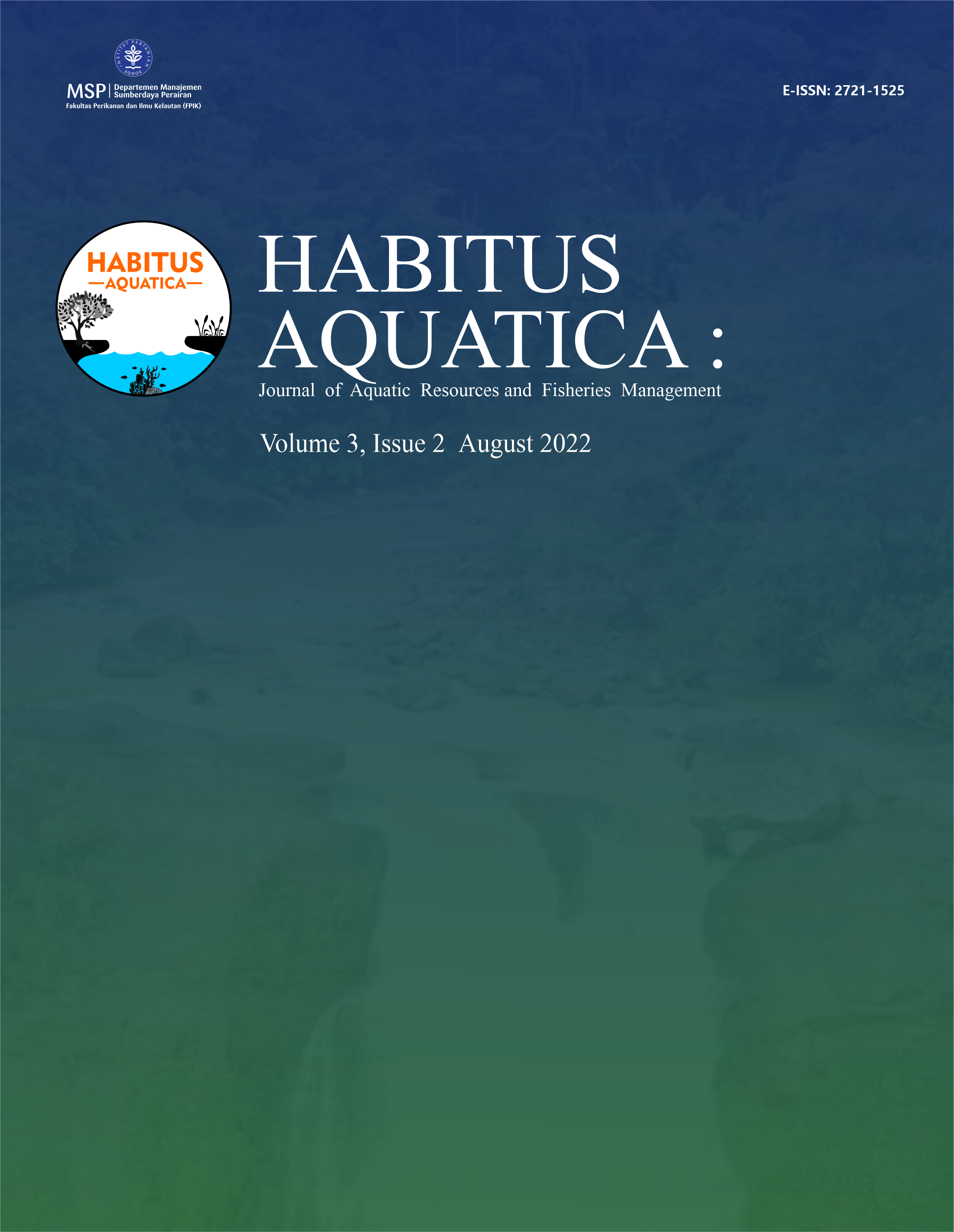Water Quality of Ebony Lakes in Bukit Golf Mediterania, Pantai Indah Kapuk, North Jakarta
Kualitas Air Danau Ebony di Kawasan Bukit Golf Mediterania, Pantai Indah Kapuk, Jakarta Utara
Abstract
Ebony Lakes is an artificial lake that used as flood control and as an aesthetic function to raise the aesthetic value of the residential. The study was conducted for the purpose of proving that the operational management of the Lake Ebony improve the water quality of the lake. This research was conducted from March 2014-February 2015. Analysis method used in this research is the Pollution Index and STORET Index. Ebony lake contamination levels based STORET Index on the surface and the bottom water with the value range from -40 to -52. Pollution index values that was obtained from the surface and the bottom waters of Ebony Lake range from 1.54 to 10.26. Ebony polluted lake conditions was seen from parameters that was exceeded the quality standards class III PP no 82 tahun 2001, such as COD, BOD5, nitrites, H2. Status Ebony Lake based on Pollution Index relatively lightly polluted to heavily polluted. Based on STORET Index Ebony Lake, water quality status indicates heavily polluted conditions at each station with a higher trend in dry season than the wet season.
Downloads
References
American Public Health Association [APHA]. 2012. Standard Methods for the Examination of Water and Wastewater. Ed ke-22. American Water Works Association [AWWA], Water Environment Federation [WEF]. Washington DC (US): APHA.
[BMKG] Badan Meteorologi Klimatologi dan Geofisika Stasiun Klimatologi Darmaga Bogor. 2015. Data Curah Hujan Tahun 2015. Bogor (ID): BMKG.
Chapman, D. 2000. Water Quality Assesment. E & FN Spon. London.
Costa OS, Nimmo M, Cordier E. 2008. Coastal nitrification in Brazil: A Review of The Role of Nutrien Excess on Coral Reff Demise. Journal of South American Sciences. Vol (210). Hal. 257-270.
Dwight RH, Caplan JS, Brinks MV, Catlin SN, Buescher G, Semenza JC. 2011. Influence of variable precipitation on coastal water quality in Southern California. Water Environmet Research. 83(12):2121-2130.
Ford D, Williams P. 1989. Karst Geomorphology and Hidrology. London: Chapman and Hall.
Guo F, Yuan D, Qin Z. 2009. Groundwater Contamination in Karst Areas of Southwestern China and Recommended Countermeasure. Karst Dynamics. Vol 39(2). Hal.389-399.
Hadijah O. 2002. Kajian Morfometri dan Karakteristik Kualitas Air Situ Cilala, Kemang, Bogor, Jawa Barat. [skripsi]. Bogor (ID): Institut Pertanian Bogor.
Herlambang A. 2005. Pencemaran Air dan Strategi Penanggulangannya. Jurnal Lingkungan.. Vol 2 (1). Hal 1-14.
Hoerunisa I. Kajian Morfometri dan Karakteristik Kualitas Air Perairan Situ Malangnegah, Kecamatan Ciseeng, Kabupaten Bogor, Jawa Barat. [skripsi]. Bogor (ID): Institut Pertanian Bogor.
[KepMenLH] Keputusan Menteri Lingkungan Hidup. 2003. Keputusan Menteri Lingkungan Hidup Nomor 115 Tahun 2003 tentang Pedoman Penentuan Status Mutu Air. Jakarta (ID): KepMenLH.
Kurniawan B. 2006. Analisis Kualitas Air Sumur Sekitar Wilayah Tempat Pembuangan Akhir Sampah (Studi Kasus di TPA Galuga Cibungbulang Bogor). [skripsi]. Bogor (ID): Institut Pertanian Bogor.
Kusnaedi.2010. Mengolah Air Kotor Untuk Air Minum. Penebar Swadaya: Jakarta
Maniagasi R, Tumembouw SS, Mundeng Y. 2013. Analisis Kualitas Fisika Kimia Air di Areal Budidaya Ikan Danau Tondano Provinsi Sulawesi Utara. Jurnal Budidaya Perairan. Vol 1 (2). Hal 29-37.
Nugroho N. 2002. Analisis Beberapa Aspek Limnologis Situ Cibuntu, Cibinong, Bogor, Jawa Barat. [skripsi]. Bogor (ID): Institut Pertanian Bogor.
Ott WR. 1978. Enviromental Indices: Theory and Practice, Ann Arbor Science Publishers Inc,. Michigan, 1978.
Ouseph PP, Prasanthan V, Abhilash PP, Udayakuma P. 2007. Occurrence and Distribution of Some Enteric Bacteria Along The Soutern Coast of Kerala. Chemical Science Division, Centre For Earth Science Studies Thiruvananthapuram India. Indian Journal of Marine Science. Vol 38 (1). Hal. 97-103.
Permana RS. 2012. Kelayakan Air Sumur Sebagai Sumber Air Bersih di Desa Sendangsari Kecamatan Pajangan Kabupaten Bantul. [skripsi]. Yogyakarta (ID): Universitas Negeri Yogyakarta.
[PerMenLH) Perturan Menteri Lingkungan Hidup. 2008. Peraturan Menteri Lingkunga Hidup Nomor 20 Tahun 2008 tentang Petunjuk Teknis Standar Pelayanan Minimal Bidang Lingkungan Hidup Daerah Provinsi. Jakarta (ID): PerMenLH.
Rosadi D. 2006. Tinjauan Kualitas Air Tanah di Daerah Karst Sukolilo dan Sekitarnya, Kabupaten Pati, Jawa Tengah. Jurnal Geologi Tata Lingkungan. Vol 16 (1). Hal 24-27.
Saeni MS. 1989. Kimia Lingkungan. Depdikbud, Ditjen Pendidikan Tinggi. PAU – Ilmu Hayat, IPB. Bogor.
Salmin. 2005. Oksigen Terlarut (DO) dan Kebutuhan Oksigen Biologi (BOD) Sebagai Salah Satu Indikator untuk Menentukan Kualitas Perairan. Jurnal Oseana. Vol 30 (3). Hal 21-26.
Stankovic I, Ivancica T, Furax L. 2010. Crustacean Plankton Community in Gypsum Karst Lakes and Their Relation to Abiotic Parameters. Jounal Hylobiologia. Vol 666. Hal 145-153.
Subchan M. 2008. Kajian Keberadaan Penambangan Marmer di Karst Hutan Lindung Bulusaraung Studi Kasus di Kelurahan Leang-Leang Kecamatan Bantimurung, Kabupaten Maros, Provinsi Sulawesi Selatan. [skripsi]. Bogor (ID): Institut Pertanian Bogor.
Subratayati AMF. 2008. Kajian Tentang Pengembangan Sumberdaya Air Sungai Bawah Tanah Bribin di Kecamatan Semanu Kabupaten Gunung Kidul DIY. [tesis]. Surakarta (ID): Universitas Sebelas Maret Surakarta.
Vaheedunnisha, Shukla SK. 2013. Water Quality Assessment of Roop Sagar Pond of Satna using NSF-WQI. International Journal of Innovative Research In Science, Engineering and Technology. Vol 2. Hal 5.
Vuckovic I, Bozak I, Ivkovic M. 2009. Composition and Structure of Benthic Macroinvertebrate Communities in The Mediterranean Karst River The Cetina And Tributary The Ruda, Croatia. Journal Scientific. Vol 18(1). Hal 49-82.
Wetzel RG. 2001. Limnology. Lake and River Ecosystems. 3rd. Ed. Academic Press, San Diego, CA, USA
Welch EB, Lindell T. 1992. Ecological effects of Wastewater: Applide Limnology and Pollution Effects. Chambridge University Press. 452p.
Copyright (c) 2024 Habitus Aquatica

This work is licensed under a Creative Commons Attribution-ShareAlike 4.0 International License.
Authors submitting manuscripts should understand and agree that copyright of manuscripts of the article shall be assigned/transferred to Habitus Aquatica Journal. This work is licensed under a Creative Commons Attribution-ShareAlike 4.0 International License (CC BY-SA). Therefore, Authors and Readers are permitted to share — copy and redistribute the material in any medium or format, and adapt — remix, transform, and build upon the material for any purpose. However, they must give appropriate credit, provide a link to the license, and indicate if changes were made. If you remix, transform or build upon the material, you must distribute your contributions under the same license as the original.


















